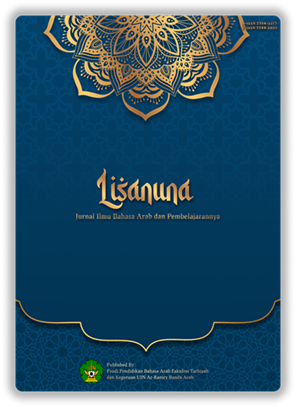Implementasi Metode Mindmapp Dalam Pembelajaran Ilmu Nahwu Siswi XI Program Keagamaan MAN 1 Probolinggo
DOI:
https://doi.org/10.22373/ls.v13i1.18026Keywords:
Mindmapp Menthod, Grammer Science, creativity.Abstract
In this journal the authors conduct research with the aim of knowing 1) the effectiveness of mindmapp media in studying nahwu science. 2) Mind maps can attract students' attention in learning. 3) Mindmapp is a solution in understanding nahwu science. Data were collected by observation and interviews with 5 students of the Religious Program using descriptive and qualitative techniques. The subjects and objects of this study were students of class Xl in the Man 1 Probolinggo Religious Program. The results of research in the field are as follows: 1) Mindmapp media makes it easier for some Man Pk students to understand nahwu material which is difficult to discuss. 2) The existence of Mindmapp increases the creativity of students in creating and processing data. 3) The existence of a mind map makes it easier for students to repeat material and memorize.
Downloads
References
Ambar Sulianti, Sukma Nurwidiani, siti sarah I. S. (2020). Jurnal Penelitian Psikologi Metode Pembelajaran Mind Mapping dan Musik Klasik. Jurnal Penelitian Psikologi, 3441.
Arif Pramana Aji, M. M. (2022). PENINGKATAN HASIL BELAJAR BAHASA ARAB MATERI QAWAID MELALUI METODE MIND MAP BAGI MAHASISWA TAMHIDY MA’HAD BILAL BIN RABAH. PAIDA, 1(1), 40–59.
Arif Rahman Hakim. (2013). Mempermudah Pembelajaran Ilmu Nahwu pada abad 20. Al-Maqoyis, 1(1).
Emi Rofi’ah, Nonoh Siti Aminah, E. Y. E. (2013). PENYUSUNAN INSTRUMEN TES KEMAMPUAN BERPIKIR TINGKAT TINGGI FISIKA PADA SISWA SMP Oleh: Emi Rofiah, Nonoh Siti Aminah, Elvin Yusliana Ekawati Program Studi Pendidikan Fisika Fakultas Keguruan dan Ilmu Pendidikan Universitas Sebelas Maret. 1(2), 17–22.
Fatmawati, R. (2021). Pembelajaran Qiràah Dasar: Studi Kasus Pada Metode Sorogan di Pondok Pesantren. Chalim Journal of Teaching and Learning, 1(1), 26–34. https://doi.org/10.31538
Hidayat, H., Mulyani, H., Fatimah, A. S., Sholihat, A., Latifah, A. Z., Islam, U., Sunan, N., & Djati, G. (2020). PENERAPAN METODE MIND MAPPING UNTUK. Jurnal Pendidikan, 21, nomor, 38,50.
Ihwan, M. B., Mawardi, S., & Ni’mah, U. (2022). Pengaruh Penguasaan Ilmu Nahwu Dan Sharaf Terhadap Kemampuan Membaca Kitab Fathul Qarib. TADRIS AL-ARABIYAT: Jurnal Kajian Ilmu Pendidikan Bahasa Arab, 2(1), 61–77.
Iriani Faizah, Subiki, A. S. (2020). METODE MIND MAPPING PADA PEMBELAJARAN FISIKA POKOK B erdasarkan permasalahan yang diuraikan di atas , maka peneliti mencoba satu cara untuk meningkatkan kualitas pembelajaran fisika menggunakan metode mind mapping yang merujuk pada peningkatan kemampuan.
Mualif, A. (2019). Metodelogi pembelajaran ilmu nahwu dalam pendidikan bahasa arab. AL-HIKMAH, 1(1), 26–36.
Nurcholis, A., Hidayatullah, S. I., & Rudisunhaji, M. A. (2019). Karakteristik Dan Fungsi Qira’Ah Dalam Era Literasi Digital. El-Tsaqafah : Jurnal Jurusan PBA, 18(2), 131–146. https://doi.org/10.20414/tsaqafah.v18i2.1853
Pea, O., Meishanti, Y., Rahmawati, R. D., & Jannah, R. (2020). Pelatihan Berbahasa Arab Melalui Keterampilan Berbicara ( Maharah al-kalam ) Metode Muhadatsah menggunakan Pocket Book. 1(1).
Prof., D. sugiyono. (2011). prof. dr. sugiyono, metode penelitian kuantitatif kualitatif dan r&d. intro ( PDFDrive ).pdf. In Bandung Alf (p. 143).
Rijal Darusman. (2014). Penerapan metode mind mapping (peta pikiran) untuk meningkatkan kemampuan berpikir kreatif matematik siswa smp. Ilmiah, 3(2), 164–173.
Sa, N. (2019). Problematika Pembelajaran Nahwu bagi Tingkat Pemula Menggunakan Arab Pegon. Lisanan Arabiya, 3(1), 3–12.
Sandu Siyoto, & Sodik, M. A. (2015). Dasar Metodologi Penelitian Dr. Sandu Siyoto, SKM, M.Kes M. Ali Sodik, M.A. 1. Dasar Metodologi Penelitian, 1–109.
Sari, D. P. (2022). Penggunaan Tehnik Mind Mapping Pada Mata Pelajaran Pendidikan Agama Islam Dalam Meningkatkan Kreatifitas Dan Hasil Belajar Siswa Di SMP 41 Seluma. 2, 87–98.
Sidik, A., & Muassomah, M. (2021). Implementasi Metode Mind Mapping dengan Menggunakan Media Power Point dalam Pembelajaran Nahwu. Alsina : Journal of Arabic Studies, 3(2), 241–260. https://doi.org/10.21580/alsina.3.2.6734
Wulandari, F. A., & Wardani, K. W. (2019). Peningkatan Keterampilan Berpikir Kreatif Siswa Kelas 5 Menggunakan Model Mind Mapping. 3(1), 10–16.
Downloads
Published
Issue
Section
License
1. Proposed Policy for Journals That Offer Open Access Authors who publish with this journal agree to the following terms:
1.a. Authors retain copyright and grant the journal right of first publication with the work simultaneously licensed under a Creative Commons Attribution License that allows others to share the work with an acknowledgement of the work's authorship and initial publication in this journal.
1.b. Authors are able to enter into separate, additional contractual arrangements for the non-exclusive distribution of the journal's published version of the work (e.g., post it to an institutional repository or publish it in a book), with an acknowledgement of its initial publication in this journal.
1.c. Authors are permitted and encouraged to post their work online (e.g., in institutional repositories or on their website) prior to and during the submission process, as it can lead to productive exchanges, as well as earlier and greater citation of published work (See The Effect of Open Access).
2. Proposed Policy for Journals That Offer Delayed Open Access Authors who publish with this journal agree to the following terms:
2.a. Authors retain copyright and grant the journal right of first publication, with the work [SPECIFY PERIOD OF TIME] after publication simultaneously licensed under a Creative Commons Attribution License that allows others to share the work with an acknowledgement of the work's authorship and initial publication in this journal.
2.b. Authors are able to enter into separate, additional contractual arrangements for the non-exclusive distribution of the journal's published version of the work (e.g., post it to an institutional repository or publish it in a book), with an acknowledgement of its initial publication in this journal.
2.c. Authors are permitted and encouraged to post their work online (e.g., in institutional repositories or on their website) prior to and during the submission process, as it can lead to productive exchanges, as well as earlier and greater citation of published work (See The Effect of Open Access).

